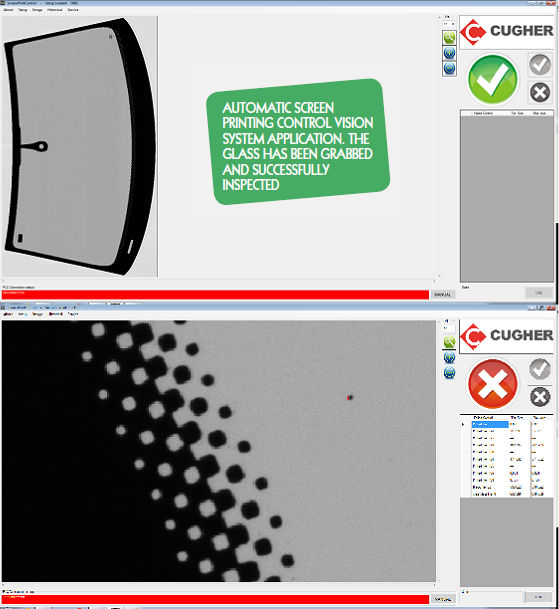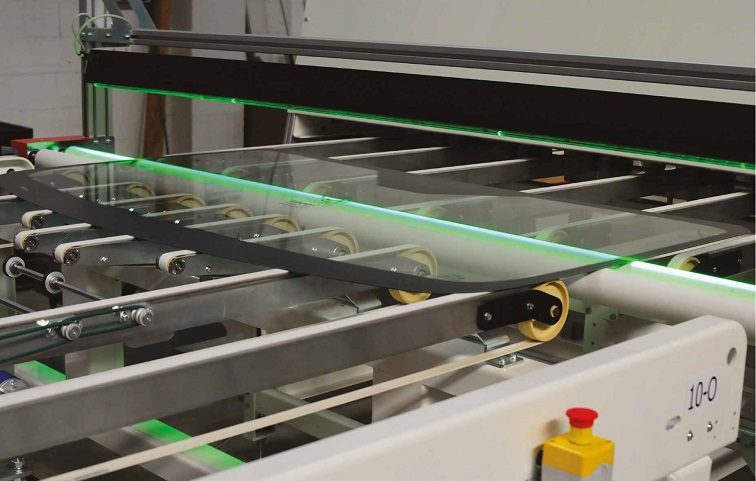
Vision Systems use customized Illuminators for a better detection of defects
The continuous reduction of cycle times and the improvements of finished product quality imposes the intensification of automation of both production monitoring systems and quality control. Automation and constant production monitoring are the main features of Industry 4.0, and, when applied to production cycles, artificial vision systems allow to monitor and automatically set some production parameters. Cugher Glass, has, for over 50 years, been a reference in the market of flat glass for its cutting-edge solutions dedicated to screen printing. Thanks to the partnership with Acelabs, a company that designs and manu- factures artificial automatic vision systems for quality control,

Cugher Glass offers its customers the opportunity to control the glass in the best way possible and print quality in each and every detail – thanks to the very high resolution reached by its devices – as well as to monitor and adjust the process using optical systems designed for automatic screen centring and automatic control of broken screens. The high potential of customization and constant objectivity in evaluation make artificial vision systems the right solution to have 100 per cent automated production control.
AUTOMATIC GLASS QUALITY INSPECTION VISION SYSTEM
The quality inspection vision system, typically installed downstream from the washing machine, is able to scan the whole glass and detect any defects present, such as scratches, breakages, air bubbles, chips, contaminations, water drops, wet edges. The system inspects raw glass or cut and ground glass through specifically designed optical technology that uses an alternate light source pattern which can detect any type of glass defect, even the smallest. During the setup phase, the quality manager defines the desired level of sensibility for defect types. Moreover, different sensibility areas can be defined on all the glass surface to set higher sensitivity in the centre instead of close to edges.

AUTOMATIC PRINT QUALITY VISION SYSTEM
The automatic print system, installed immediately after the printing machine, recognizes any

BROKEN SCREEN DETECTION AND QUALITY VISION SYSTEM IN CUGHER’S LINE
‘slavering’ or ‘widening’ of the design details due to an excess of ink coming from the screen. This type of inspection is able to detect fade out dots, pin holes, or if there are missing parts of the design, alerting the operator to verify the possible cause. All the areas of the glass are checked and compared with the allowed tolerances specified in the glass inspection recipe, which is created as a ‘one-off’, using preloaded images obtained using ‘good’ glass or the digital image. Different sensibility areas can be defined on all the glass surface to allow higher control, for instance on logos and barcodes. A specific software option provides controls on particular details, for example fiducial marks or special symbols or even ISO verification on barcode/datamatrix or OCV (optical character verification) on text. The system is capable to perform retro actions, sending the adequate signals back to the printing machine to automatically modify the screen position in real time, with the aim of operating automatic limited screen adjustment starting from an optimal print. In general, the software can send defined signals to the printing machine’s PLC to activate specific functions and automatically optimize the production. The advantages of this innovative system are the possibility to verify print quality, tracking the defects on images and, in the case of errors, to automatically correct frame position without stopping the conveyor. The hardware on these two technologies foresees the use of a high resolution monochromatic linear camera with 16384 pixels, that guarantees resolution up to 60μm for 1,000mm glass and 122 μm for 2,000mm glasses (on leading long edges). It is able to verify design quality up to a circular dot of 0.09mm2 (on 1,000mm glass) or 0.36mm2 (on 2,000mm glass). The digital camera acquires one line at time, ‘scanning’ the glass during its movement on the conveyor. An innovative lighting system is adequately positioned to allow the camera to have optimal light conditions. The faulty areas and the acquired image are then showed on a wide screen (42”) high resolution monitor and the good glass image used in the recipe creation phase can be displayed in overlay.

The operator can ‘surf’ the whole glass surface and, if necessary, zoom on selected areas to analyse image details. Moreover, the software shows the error detected and highlights the specified area on the monitor. After inspection, the glass can then be diverted to a visual inspection station where the operator performs an extra inspection without halting the line.

AUTOMATIC SCREEN REGISTRATION SYSTEM WITH CAMERAS
The automatic screen registration system is composed of two cameras installed under the printing table and driven by two servo-motors to store the data in the recipe. The system automates the adjustment of the screen with the glass to be printed. The recipe is creating by placing a sample glass on the printing table and the cameras are driven in jog to visualize the referential targets. Once found, the targets are saved in the recipe and showed on the monitor. The sample glass is then unloaded, the screen provided with targets in adequate positions is inserted, and the cameras detect the screen position. The operator leads the screen approximately to the right position so that it is blocked and, using the motorized calibres, the accurate positioning operations are automatically performed by dedicated software, until the targets have been matched. The images of the two cameras, showing the targets, are displayed on a monitor, while the operator has the commands to move the cameras and the motors for further screen movements on his touch panel. Using the automatic screen registration system, allows to obtain a complete model changeover in an extremely short time: thanks to the completely automatic machine setup, the operator’s actions are reduced only to the inserting of the new screen into the printing machine.

BROKEN SCREEN DETECTION SYSTEM
This special unit has been studied to allow the control of the glass and to check, by means of a dedicated video camera and
expressly developed software, the presence of ink spots on the lower surface of the glass.
This unit is positioned just downstream from the printing machine, so that it can automatically detect if there is a broken screen. The minimum detectable spot is a circle with the diameter of 1mm on a conveyor of 2,000mm width.
The advantage of this innovative system is that it doesn’t matter where the screen has been broken or how ‘small the hole is, if there is a leakage of ink, this unit will detect it.


